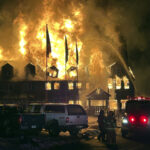Three months into the new year, the picture for the California workers’ comp market is not pretty, and it’s likely to get worse. Developments in recent weeks-including lowered ratings, carrier losses, declining profits and the ongoing hunt for some kind of solution-serve to illustrate the negative trend.
Paula’s rating drops
On March 9, A.M. Best lowered the rating of Paula Insurance Company from “B” to “B-” and placed the Pasadena-based company under review with developing implications.
Matthew Mosher, vice president of specialty commercial lines with A.M. Best in Oldwick, N.J., indicated that the rating drop is pretty much in line with the state of the workers’ comp market. “It’s certainly reflective of the market conditions and the difficulties that many companies are having getting the appropriate reserve levels established,” he said. “While Paula had maintained fairly high leverage…their leverage is even higher at this point, so we certainly have concern and are reviewing some of their reinsurance programs that they’re putting into place.”
Mosher said one such arrangement is with Insurance Corp. of Hannover, put in place July 1, 2000. According to Mosher, because the program is on a policy-issued basis, it did not have a measurable effect on the 2000 calendar year, but will have a greater impact going forward in 2001. “At this point, [Paula is] just evaluating different strategies to either boost capital or improve underwriting leverage itself through possibly reinsurance transactions,” he said.
Mosher described the carrier’s financial condition as “weak.” “Right now we have the rating in the ‘vulnerable’ category. I think their profitability is certainly improved over the past year or two, their underwriting is improved; but the hole that had grown due to the reserve deficiencies throughout the prior years has really put them in a weak position at this point.”
Paula specializes in the underwriting and servicing of workers’ comp for labor-intensive agribusinesses throughout the major growing areas of the U.S. Policies are largely written through its affiliates: Pan American Underwriters Inc. in California, Pan American Underwriters Insurance Agents and Brokers Inc. in Arizona, and Agri-Comp Insurance Agency Inc. in Oregon.
Mosher does not see the rating drop shaking up the market too much. “I think the marketplace has pretty much accepted companies in a similar situation,” he said. “It’s basically a marketwide phenomenon. Obviously, there are some strong carriers still out there, but probably the reason they’re strong is that they historically have charged higher prices.”
These carriers include private companies such as Zenith, Republic Indemnity and Argonaut, Mosher said. Although Argonaut saw a slip in its ratings last year, “they still have a substantial amount of capital to support the business that they write.”
Fremont struggles
Meanwhile, Santa Monica-based Fremont General Corp. is working hard to find a way out of its current slump.
Fremont Executive Vice President and CFO Wayne Bailey reported during a recent conference call that Fremont General recorded a pre-tax loss of approximately $692 million on a consolidated basis for the year 2000.
“The loss was a result of a significant increase in net loss and loss adjustment reserves during the second quarter and the expenses associated with the announced restructuring of the workers’ compensation insurance operation in the fourth quarter,” Bailey said. “The restructuring resulted in a write-off of approximately $200 million in goodwill and other intangible assets.”
|
||||||||||||||||||||||||||||||||||||||||||||||||||||||||||||||||||||||||||||||||||||||||||||||||||||||||||||||||
News of the loss resulted in shares falling 34 cents, or about 9 percent, to $3.46 on the New York Stock Exchange. Over the last three years, as Fremont has battled for profitability in its workers’ compensation line, the stock value has crept down 89 percent.
Fremont Compensation Insurance Group reported a pre-tax loss of about $750 million for the year 2000, according to Bailey. Gross written premium in 2000 was a total of $1.1 billion. Gross written premium in force decreased to approximately $695 million at year-end 2000.
“As we’ve discussed before, we’ve been trying to reduce the average policy size and target the small account market,” Bailey said. “The average policy size at year-end 2000 was $10,500; and 91 percent of our policies are $25,000 or smaller in size.”
The last few months have not been easy for Fremont. “One of the things we continue to struggle with a bit here is the lower Best rating that we have-it’s making it difficult for us to attract a lot of premium,” Bailey said. “We’re renewing about 25 percent of our book with an average rate increase of around 50 percent. So, what we are retaining is seeing rather substantial rate increases; and we’re continuing to go through the book and price it to a point where we believe, based upon everything that we’ve seen so far, the book will generate a reasonable loss ratio.”
|
|||||||||||||||||||||||||||||||||||||||||||||||||||||||||||||||||||||||||||||||||||||||||||||||||||||||
Bailey said that Fremont is writing some new business in workers’ comp “at the smaller end of the market.” The company is also working on a fronting arrangement with an unnamed “A” rated carrier, “which should enable us to hold a larger portion of that book of business,” Bailey said. “We’ve reached an agreement with them, and we’re just waiting for regulatory approval.
“We’re trying to bring that combined ratio somewhere in the 105 range to make the business profitable to us…it’s going to take some time to have that run through the whole book. So at this point, we are hopeful that we can take the insurance operation and work it into a break-even status this year and look for profitability next year should these rate increases and some of the premium hold.” Bailey said he sees a possible $400 million of net premiums written for the year 2001.
Profits decline
Weiss Ratings Inc., an independent provider of insurance company ratings and analyses, reported that the nation’s workers’ comp insurers were hit with an 86-percent decline in profits. Profits that were up to a high of $1 billion during the first nine months of 1998 had dropped to $144 million during the same period in 2000. The p/c industry as a whole saw a 6-percent drop in profits during the same time period.
Workers’ comp insurers also had a failure rate (7.7 percent) in 2000 that was 12 times higher than the failure rate of all other p/c insurers combined (0.6 percent).
“A common reason for these failures is inadequate policy reserves to cover the rising losses; to avoid failure, companies often resort to large premium increases to help shore up reserves. Consequently, buyers of workers’ comp can expect to see double-digit rate increases for the next few years,” Martin D. Weiss, Ph.D., chairman of Weiss Ratings, stated in the report. “In the 1990s, workers’ comp insurers severely underpriced policies and loosened underwriting standards. As with any type of insurance, this laxity eventually catches up with a company and becomes a serious drain on profits.”
Assembly hearings continue
Back at the State Capitol, Assembly Insurance Committee Chairman Thomas Calderon has been overseeing a series of hearings on the dire condition of the workers’ comp market.
At the second hearing held March 14, ABL Lobbyist John Norwood presented the results of a recent IBA West member survey, which revealed that the cost of workers’ comp insurance to California employers has risen substantially in the last year throughout the state and the economy. At the same time, the number of agency appointments to write comp insurance has gone down and the reliance on the State Compensation Insurance Fund has increased substantially, the survey found.
“Ninety-five out of 147 agencies (64 percent) said that 100 percent of their clients-every single employer-was paying more for workers’ comp insurance today than a year ago,” Norwood told the committee. “An additional 30 percent of agencies reported that between 90 and 99 percent of employers were paying more.” Norwood also said premiums increased in 2000 by as much as 400 percent, but 52 percent of agencies reported their employers were paying average premium increases of between 11 and 20 percent.
“Employers are aware of, and very concerned about, the solvency of workers’ comp insurers,” Norwood said. “More than half of agencies reported that employers had expressed concerns or asked questions about their own insurance company’s solvency.”
|
||||||||||||||||||||||||||||||||||||||||||||
|
||||||||||||||||||||||||||||||||||||||||||||
|
|||||||||||||||||||||||||||||||||
|
||||||||||||||||||||||||||||||||||||||||||||
|
||||||||||||||||||||||||||||||||||||||||||||
According to IBA West’s survey, agents are also going on fewer appointments related to workers’ comp. More than half of the responding agencies reported that various insurers were refusing to write or renew particular comp classifications-especially building contractors and artisans, farms, and new ventures.
Reliance on the State Fund is increasing, according to the survey results. “A year ago, the State Fund was the largest workers’ comp market for about one-third of the respondents,” Norwood said. “On Jan. 1 of this year, it was the largest for almost 70 percent of the agencies.”
Norwood closed with a plea to the committee not to aim legislation efforts at the State Fund and recognized the difficulties currently plaguing the market. “Whatever you do, don’t make the current situation worse,” he said.
Topics California Carriers Agencies Profit Loss Legislation Workers' Compensation Underwriting
Was this article valuable?
Here are more articles you may enjoy.


 Acrisure CEO Greg Williams Makes $400M Commitment to Michigan State University
Acrisure CEO Greg Williams Makes $400M Commitment to Michigan State University  Pierce Named CEO of GEICO as Combs Resigns
Pierce Named CEO of GEICO as Combs Resigns  Florida Jury Returns $779M Verdict for Family of Security Guard Killed at Gambling Cafe
Florida Jury Returns $779M Verdict for Family of Security Guard Killed at Gambling Cafe  Owner of Historic Minnesota Resort Charged With Arson, Insurance Fraud
Owner of Historic Minnesota Resort Charged With Arson, Insurance Fraud 


